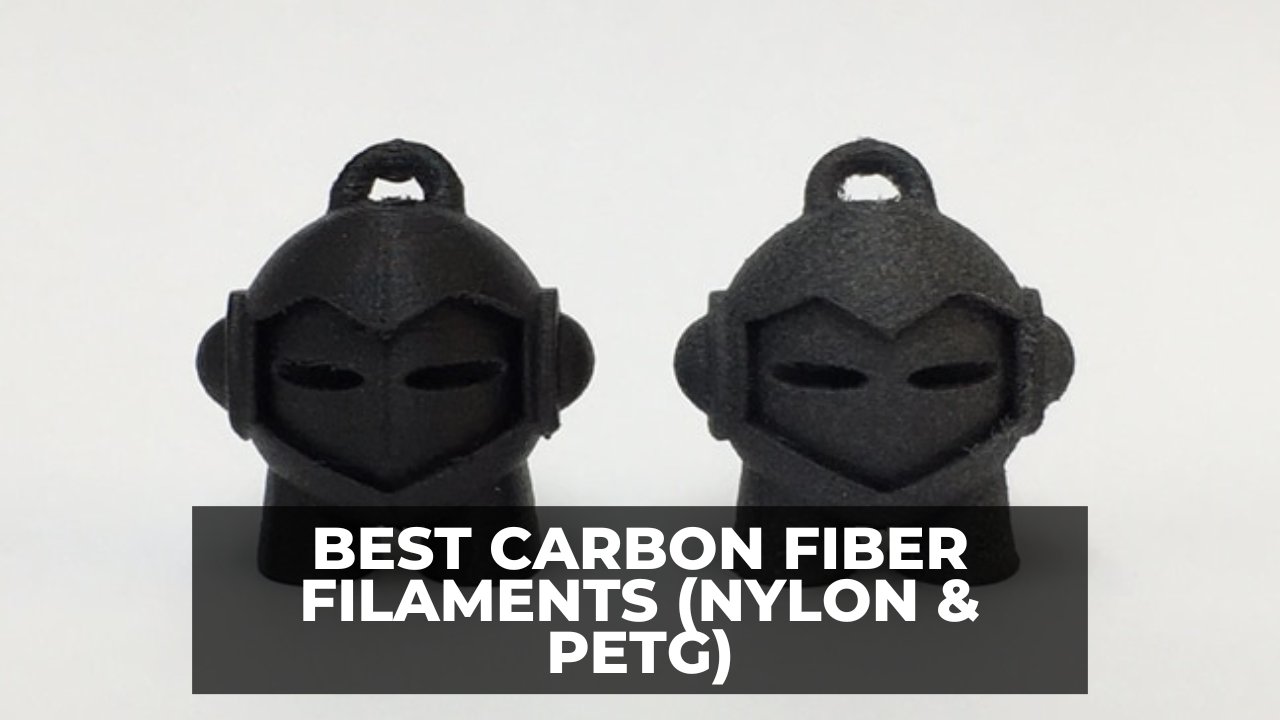
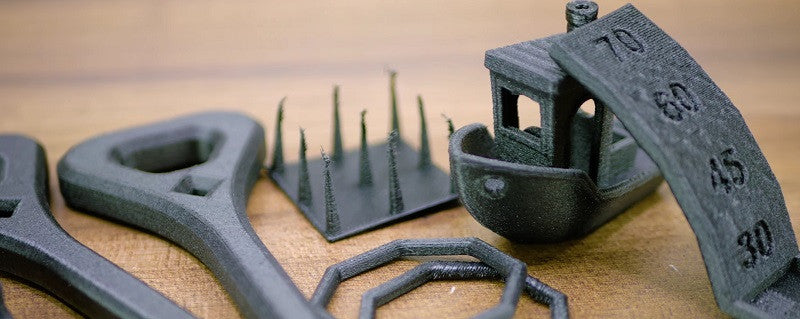
Just a few short years ago, 3D printers were restricted to just your regular PLA and ABS filaments on any machine costing less than $30,000 or so.
Now, you’re able to print with nearly any material you want, on a desktop printer for about $1000. And one of the most exciting new options is Carbon Fibre composite filaments
It’s one of my favorite materials, with an incredible strength-to-weight ratio, good tensile strength, and resistance to corrosion and fatigue.
The best carbon fiber filament I’d recommend for most users is NylonX from Matterhackers. It offers the best performance for a majority of uses. It’s extremely durable, with a low friction coefficient and impressive heat stability
That said, XT CF20 Colorfabb is the cheapest option if you’re looking for a budget pick, why Onyx is an ultra-high-performance choice for pro prints.
We’ll also break down exactly what carbon fiber filament is so you can be sure carbon fiber is the right material for you before investing.
What is Carbon Filament?
It’s important not to get confused, or have unrealistic expectations here. Carbon fiber filament is not the same as the carbon fiber you might expect to find in high-performance race cars or aircraft. The processes, materials used, and the design are all completely different.
Typical fiber-based composites are large, long sheets of woven fibers sealed in a tough epoxy-based resin, not a re-meltable thermoplastic (like filaments are).
Frustratingly most CF (Carbon Fiber) filaments available at the moment are just PLA mixed with CF dust. Now, PLA is typically very brittle (certainly most varieties of it are) and adding another brittle material in the form of a powder essentially creates one of the most brittle printing materials you could think of. That’s Carbon Fiber PLA.
That’s the reason (and I may get slated for this) you’re not going to find Carbon Fibre PLA filament in this “best of” article. That’s because PLA does not complement carbon.
For similar reasons, we’re not going to cover Carbon Fibre ABS filament here either.
A better use of your time (and money, because CF filament isn’t cheap) would be to choose a base material with excellent durability to counter Carbon’s potentially brittle (but very hard) nature. That way, you’ll be left with prints that exude rigidity, hardness, and durability. Which, let’s face it, is the golden set of properties for high-performance applications.
Using materials like PETG and Nylon, or other better performing resins, with small particles (or strands) of CF inside, makes a version of the material closer to what you’d expect. The base resin used, amount of CF, and size of the individual particles of carbon in the material affect a range of factors, including printability, cost, and finished part strength.
Make no mistake: the right blend of resin and CF can make a superior, hard, stiff, and durable material that will rival any other filament available for consumer-level FDM printing today. So for those projects where nothing else will do, carbon could be your go-to filament.
You can treat this article as a mini carbon fiber filament review. Let’s take a look at the 4 highest performance 3D printer carbon fiber filament varieties currently available on the market today:
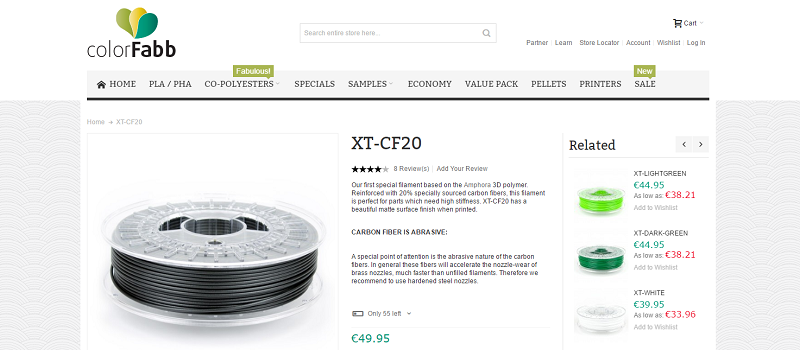
ColorFabb XT CF20 (Carbon Fibre PETG Filament)
Price: Approx. £60/KG
Thought we’d kick things off with arguably the most well-known (and cheapest) CF material on this list. ColorFabb ‘XT’ is basically the same popular PETG (think PET in plastic bottles, but Glycol-modified for strength) but with a 20% fiber reinforcement.
As with all Carbon Fiber 3D filament, it’s important you use a hardened nozzle. A regular Brass nozzle will wear out in a few short hours of printing. XT CF20 is no different, so make sure you have some hardened nozzles to hand. It’s also worth bearing in mind most fiber or composite filaments are best printed with 0.5mm or larger nozzles. If the particles in the filament are not sufficiently nano-sized then blockages can occur easily on smaller nozzle sizes.
Similar to PLA, PETG filament is rather dense so naturally, XT has a higher-end density, coming in at 1.27 g/cm³. Not so much an issue when printing most things, but if weight is a concern you may be interested in lower density materials (like Nylon) that can be up to 20% lighter for the same volume.
ColorFabb is a known industry benchmark, promising tolerances of +/-0.05mm of their advertised 1.75mm or 2.85mm sizes. Generally, the tighter the tolerances, the cleaner your prints will look – so it’s worth watching out for. Tolerances that are too wide can even lead to blockages, so be wary of +/-0.10mm variances in cheaper filaments.
Other benefits of XT CF20, in line with PETG filaments, are low warp and good durability. It is worth taking into consideration the typical printing nuances of PETG for best results, which you can find more info on here.
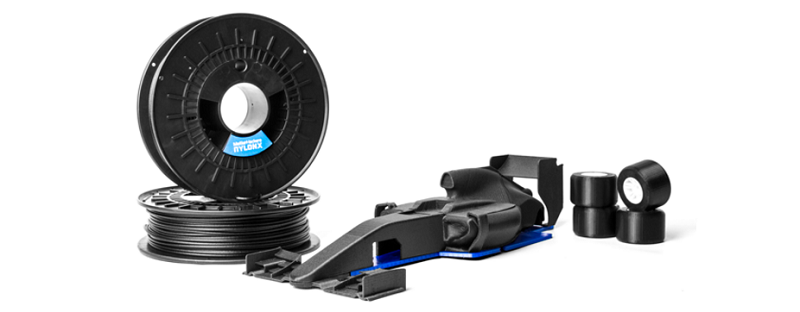
MatterHackers NylonX (Carbon Fibre Nylon Filament)
Price: Approx. £110/KG
Although PETG-based CF filaments are significantly better than ABS or PLA-based composites, the ultimate harmony of materials is Nylon and CF combined. NylonX is MatterHacker’s take on this combination of Carbon Fiber Nylon Filament.
Nylon polymer is, we think, arguably the best material currently available to 3D print with for the majority of performance applications.
Nylon is one of those materials that just has it all. Extreme durability, great chemical and heat stability and a low friction coefficient to name a few properties. And with its great durability, it naturally makes for a perfect pairing with the otherwise fairly brittle CF.
Granted, Carbon Fiber 3D Printer filament has a rougher, matte finish, so the low friction advantage isn’t as good as non-composite Nylon, but it’s still a favorable factor over other base resin materials if this is a concern.
It’s worth noting though that all Nylon based filaments should always be dried before printing. Nylon filament is extremely hygroscopic and can absorb a lot of moisture in a short time frame. If you hear popping during printing, that’ll be too much moisture.
Again as with ColorFabb’s XT CF20 above, Nylon X diameter tolerances are a reasonable +/-0.05mm of the advertised size. This is a mid-range Nylon Carbon Fiber filament.
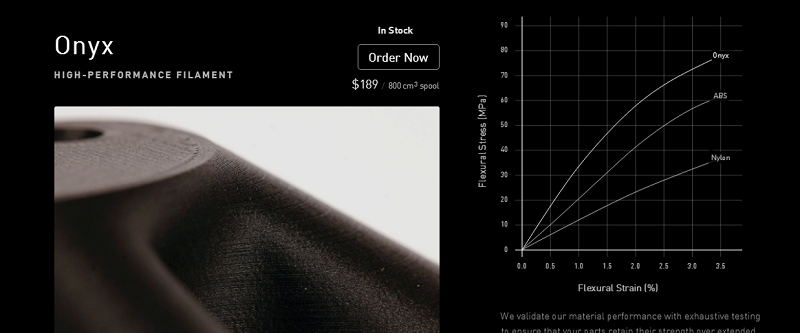
Onyx (Nylon Carbon Fiber Filament)
Price: Approx. £200/KG
Another Nylon-based CF filament (can you see a trend here?) is this one from Onyx. These are the guys behind the impressive Markforged 2 continuous fiber 3D printer. Using a continuous fiber, the prints you can get are closer in strength to more recognized CF materials.
However, this continuous approach can only currently be done on the special Markforged printer. For comparison, their carbon continuous filament is priced at an eye-watering £2500/KG.
For everyone else, their original material ‘Onyx’ works in standard 3D printers and is simply a higher grade of Nylon and CF. It is similar to Nylon X (as above), but the quality is arguably more in keeping with what you’d expect from an ultra-high-performance material.
The only downside with this Carbon Nylon filament is the price, as it the most expensive filament in this comparison.
As to which carbon filament is for you, this is determined by what you’re actually needing it for and your budget.
We’ve covered a cheaper option, mid-range, and the high end of the market. We’ve not included it in this list, as we wanted it to be impartial, we’ve also created a Nylon 12 CF filament called Carbonyte which you can view here.
With consistent-sized nanoparticle carbon fibers, using pure high-grade Nylon 12 resin and extruded to ultra-tight tolerances of just 0.03mm+/-, you may well have found the high-performance material you’ve been looking for with Carbonyte. Our manufacturing controls and customer service are second to none.
You can watch Thomas Sanladerer’s video review of our Carbonyte here:




